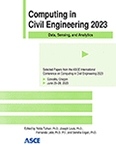Estimation of Three Mutually Orthogonal Vanishing Points from Edgelets in Road Scenes
Publication: Computing in Civil Engineering 2023
ABSTRACT
Field-of-view calibration is essential for establishing the relationship between 2D image coordinates inside the camera and 3D real-world coordinates of the traffic scene. For many surveillance-based traffic applications, the field-of-view calibration involves precisely extracting the three orthogonal vanishing points. However, many traffic scenes lack parallel lines along all three dominant directions, making it difficult to successfully calibrate using the present methods. This study proposed a novel method for estimating the three mutually orthogonal vanishing points in traffic scenes. To determine the dominant directions of the real-world coordinate frame, this method exploits the visual features of both the road environment and moving vehicles and avoids the need for parameter tuning through trial and error in different scenarios. To evaluate the performance of the proposed method, laboratory tests were conducted. The outcomes demonstrated the potential of the method in traffic scenes with scarce parallel line features.
Get full access to this article
View all available purchase options and get full access to this chapter.
REFERENCES
Barnard, S. T. (1983). “Interpreting perspective images.” Artificial intelligence, 21(4), 435–462.
Borji, A. (2016). “Vanishing point detection with convolutional neural networks.” arXiv preprint arXiv:1609.00967.
Chen, X., Ma, H., Wan, J., Li, B., and Xia, T. “Multi-view 3d object detection network for autonomous driving.” Proc., Proceedings of the IEEE conference on Computer Vision and Pattern Recognition, 1907–1915.
Dubská, M., Herout, A., and Havel, J. “PClines-line detection using parallel coordinates.” Proc., CVPR 2011, IEEE, 1489–1494.
Dubská, M., Herout, A., and Sochor, J. “Automatic Camera Calibration for Traffic Understanding.” Proc., BMVC, 8.
Fischler, M. A., and Bolles, R. C. (1981). “Random sample consensus: a paradigm for model fitting with applications to image analysis and automated cartography.” Communications of the ACM, 24(6), 381–395.
Hartley, R., and Zisserman, A. (2003). Multiple view geometry in computer vision, Cambridge university press.
Lu, L., and Dai, F. (2023). “Automated visual surveying of vehicle heights to help measure the risk of overheight collisions using deep learning and view geometry.” Computer‐Aided Civil and Infrastructure Engineering, 38(2), 194–210.
Moghadam, P., Starzyk, J. A., and Wijesoma, W. S. (2011). “Fast vanishing-point detection in unstructured environments.” IEEE Transactions on Image Processing, 21(1), 425–430.
Nair, D. J., Gilles, F., Chand, S., Saxena, N., and Dixit, V. (2019). “Characterizing multicity urban traffic conditions using crowdsourced data.” PLoS One, 14(3), e0212845.
Rother, C. (2002). “A new approach to vanishing point detection in architectural environments.” Image and Vision Computing, 20(9-10), 647–655.
Shoman, M., Aboah, A., and Adu-Gyamfi, Y. (2021). “Deep Learning Framework for Predicting Bus Delays on Multiple Routes Using Heterogenous Datasets.” Journal of Big Data Analytics in Transportation, 2(3), 275–290.
Sina, I., Wibisono, A., Nurhadiyatna, A., Hardjono, B., Jatmiko, W., and Mursanto, P. “Vehicle counting and speed measurement using headlight detection.” Proc., 2013 International Conference on Advanced Computer Science and Information Systems (ICACSIS), IEEE, 149–154.
Szeliski, R. (2010). Computer vision: algorithms and applications, Springer Science & Business Media.
Tuytelaars, T., Proesmans, M., and Van Gool, L. “The cascaded Hough transform.” Proc., Proceedings of International Conference on Image Processing, IEEE, 736–739.
You, X., and Zheng, Y. (2016). “An accurate and practical calibration method for roadside camera using two vanishing points.” Neurocomputing, 204, 222–230.
Yu, L., Zhang, D., Chen, X., and Hauptmann, A. “Traffic danger recognition with surveillance cameras without training data.” Proc., 2018 15th IEEE International Conference on Advanced Video and Signal Based Surveillance (AVSS), IEEE, 1–6.
Zhang, W., Song, H., Liu, L., Li, C., Mu, B., and Gao, Q. (2022). “Vehicle localisation and deep model for automatic calibration of monocular camera in expressway scenes.” IET Intelligent Transport Systems, 16(4), 459–473.
Information & Authors
Information
Published In
History
Published online: Jan 25, 2024
ASCE Technical Topics:
- Calibration
- Cameras
- Engineering fundamentals
- Equipment and machinery
- Frames
- Highway and road management
- Highway transportation
- Highways and roads
- Infrastructure
- Laboratory tests
- Measurement (by type)
- Structural engineering
- Structural members
- Structural systems
- Tests (by type)
- Traffic analysis
- Traffic engineering
- Traffic management
- Traffic surveillance
- Transportation engineering
Authors
Metrics & Citations
Metrics
Citations
Download citation
If you have the appropriate software installed, you can download article citation data to the citation manager of your choice. Simply select your manager software from the list below and click Download.
